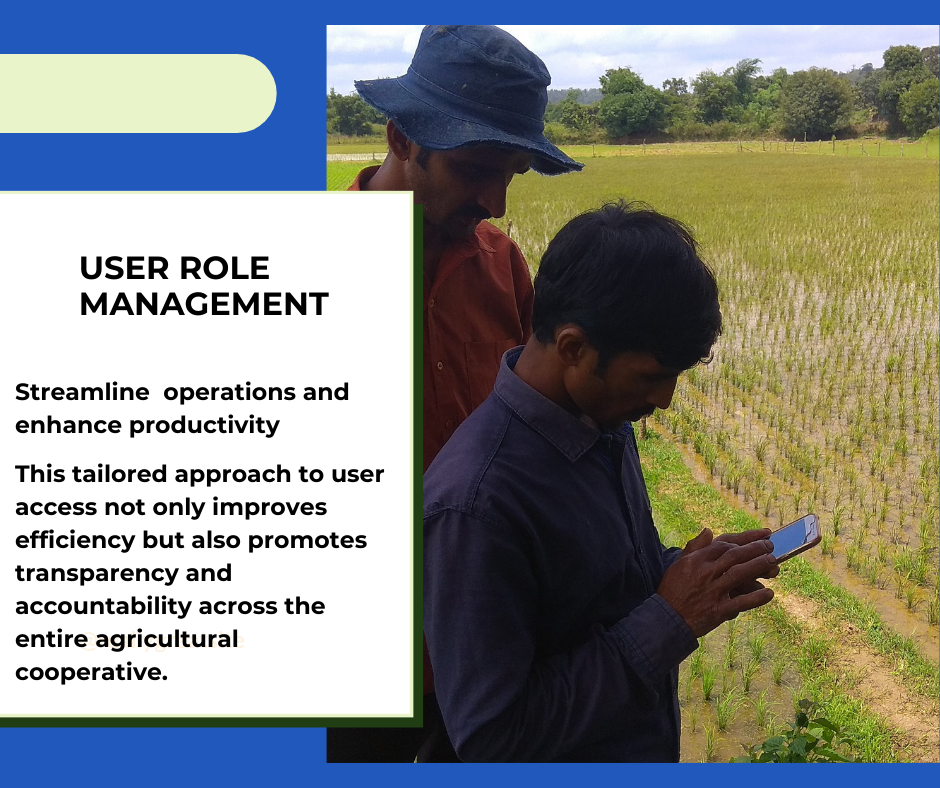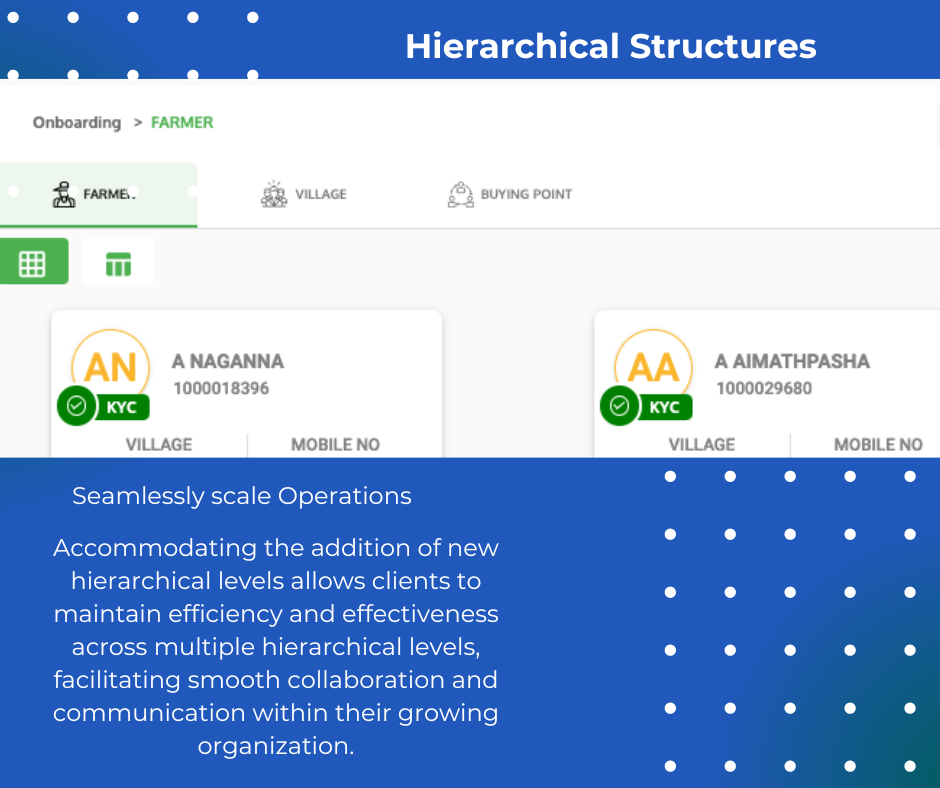Contact: +91 99725 24322 |
Menu
Menu
Quick summary: Unlock the potential of efficient communication and streamlined operations with TraceX Solutions. Explore how our platform navigates user roles and hierarchy seamlessly, optimizing collaboration and enhancing productivity across agricultural cooperatives.

Navigating the complexities of user roles and hierarchical structures within supply chain management is a pivotal aspect of ensuring seamless operations and compliance. Discover how TraceX not only simplifies user management but also aligns it with organizational hierarchies, providing granular control over access permissions and fostering a streamlined approach to supply chain processes.
Effective farm management systems often integrate communication functionalities to prevent vital information from being overlooked and to seize opportunities for improvement. Technology-driven approaches are particularly valuable for fostering seamless communication among various stakeholders and for monitoring critical data.
In our blog, we delve into how TraceX Solutions, a leading supply chain traceability platform, empowers organizations in the agriculture sector to efficiently manage user roles. We explore the significance of role-based access control (RBAC) and hierarchical structures in enhancing productivity, security, and accountability. Join us as we navigate the intricate web of user roles and hierarchy with TraceX, redefining how agribusinesses orchestrate their operations with precision and efficiency.
User management plays a crucial role in agribusiness organizations by ensuring that individuals within the organization have appropriate access to systems, data, and functionalities based on their roles and responsibilities. This is particularly vital in farm management, where diverse activities such as crop management, supply chain operations, financial transactions, and regulatory compliance require careful control and monitoring.
Granular Access: RBAC assigns specific roles to users based on their responsibilities. Each role comes with predefined permissions, determining what actions a user can perform within a system. This granular control ensures that users have access only to the resources necessary for their tasks.
Scalability: RBAC is scalable and adaptable to organizational changes. As responsibilities evolve or new roles emerge, administrators can easily adjust access permissions without overhauling the entire system.
Organizational Hierarchy: In agribusinesses, hierarchical structures mirror the organizational chain of command. User management systems can align with this hierarchy, ensuring that access privileges align with an individual’s position within the organization.
Delegation: Hierarchical structures enable the delegation of responsibilities. Managers can delegate specific tasks to their subordinates while maintaining oversight. This not only enhances efficiency but also distributes responsibilities appropriately.
In agribusiness, various user roles play crucial roles in managing different aspects of the agricultural production and supply chain. Here’s a detailed explanation of each role:

Farmers are the primary stakeholders engaged in the production of crops or livestock. They are responsible for cultivating the land, planting crops, tending to livestock, and implementing agricultural practices to ensure a successful harvest.
Field Officers are supervisors who oversee the operations of multiple farms. They play a critical role in ensuring that farming activities are carried out efficiently, following best practices, and meeting production targets.
Supply Chain Managers are responsible for managing the logistics and distribution aspects of agribusiness. They ensure that agricultural products are efficiently transported from farms to processing facilities, distribution centers, and ultimately to consumers.
Administrators are responsible for handling the configuration, maintenance, and user permissions within the agribusiness system. They play a crucial role in ensuring the smooth functioning of the technological infrastructure that supports various agribusiness processes.
Discover how innovative solutions like TraceX are revolutionizing the way farms operate for a more sustainable future.
Explore the future of sustainable agriculture
Hierarchical structures are vital in agribusiness for organizing tasks, facilitating communication, promoting accountability, and ensuring the alignment of activities with broader strategic objectives. They provide a framework that allows for efficient management and optimization of resources at different levels of the agribusiness ecosystem.

At the farm level, a hierarchical structure helps in organizing tasks and responsibilities among individual farmers or production units. Clear delineation of roles ensures that each farmer focuses on specific tasks, leading to more efficient and productive operations. Hierarchies allow for the specialization of tasks, enabling farmers to develop expertise in specific aspects of production, such as crop cultivation, livestock management, or equipment operation. Clear hierarchies facilitate decision-making at the farm level. Farmers can make timely and informed decisions related to planting schedules, irrigation, pest control, and other crucial activities. Hierarchies establish a clear chain of accountability. Each farmer is accountable for their assigned tasks, fostering a sense of responsibility and ownership in the production process.
Technology is driving efficiency, transparency, and sustainability in agriculture.
Discover how TraceX solutions are empowering contract farmers to revolutionize their operations!
Field supervisors at the regional level oversee clusters of farms. Hierarchies here help in coordinating activities and facilitating collaboration among farmers in the same region. This level ensures that best practices are shared, resources are optimized, and regional challenges are addressed collectively. Field supervisors monitor the performance of multiple farms, providing support and guidance as needed. Hierarchical structures enable effective communication channels for sharing insights and addressing issues at the regional level. Hierarchies aid in consolidating data from various farms in a region. This data can be analyzed to identify trends, assess regional performance, and implement strategies for improvement.
The corporate level involves central administration overseeing all operations. Hierarchies at this level provide a clear structure for decision-making, policy formulation, and strategic planning. Central administration is responsible for allocating resources, both human and financial, across different regions and farms. Hierarchical structures ensure that resources are distributed according to the overall strategy and goals of the agribusiness. Corporate hierarchies play a key role in strategic planning. Top-level executives make decisions regarding expansion, diversification, technology adoption, and other overarching strategies that impact the entire agribusiness. Hierarchies facilitate effective communication channels between the corporate level and regional/farm levels. This ensures that the overall vision and goals of the agribusiness are communicated and implemented at every level.
TraceX appears to address key challenges in agribusiness by providing a role-specific, hierarchical solution that enhances operational efficiency, data security, and scalability. The tailored features for different user roles ensure that each participant in the agribusiness ecosystem has the tools and information needed to contribute effectively to the overall success of the cooperative.
Enables farmers to input and monitor crucial data such as seeding dates, fertilizers used, and weather conditions, leading to more informed decision-making. Improves efficiency by allowing supervisors to validate data and provide guidance to multiple farmers from a centralized platform. Empowers managers with comprehensive insights into crop yield trends, resource allocation, and performance metrics, facilitating informed strategic decisions.
Provides tailored permissions based on user roles, preventing information overload and ensuring each user sees relevant data. Enhances precision and efficiency by allowing users to focus on what matters most to their specific roles, reducing distractions and improving overall productivity.
Ensures that farmers have access to role-specific tools for managing their plots, addressing challenges related to data input, crop monitoring, and decision-making. This empowers farmers with personalized insights and recommendations, improving their ability to manage crops effectively. Provides supervisors with tools for overseeing multiple farms, validating data, and ensuring compliance with best practices. It streamlines oversight and guidance processes, improving the overall efficiency of regional management. Ensures that managers have access to comprehensive data and tools for making informed decisions at the corporate level. It equips managers with the insights needed to make strategic decisions for the cooperative’s growth and success.
Allows for the introduction of new levels, to oversee clusters of farms and facilitates seamless expansion and customization, ensuring that the system adapts to the growing needs and complexity of the cooperative. Provides flexibility to customize the system, addressing challenges related to changes in roles or organizational structure. It allows the cooperative to add new layers or make adjustments without disrupting the operational flow, ensuring continuity and adaptability.
Unlock first-mile visibility and optimize your supply chain with TraceX Farm Management Solutions!
Explore Trace Gro
Companies using TraceX solutions in agribusiness experience a transformative impact on data accuracy, collaboration, and resource allocation. These improvements lead to more informed decision-making, increased productivity, and the overall success and sustainability of the agricultural cooperative.
Holistic Decision Making– Companies using TraceX benefit from a holistic view of their agribusiness operations. Managers can make informed decisions based on accurate, real-time data, leading to improved overall performance.
Increased Productivity- The system’s focus on accurate data, enhanced collaboration, and efficient resource allocation contributes to increased productivity at both the individual farm and cooperative levels.
Risk Mitigation– Accurate data and informed decision-making enable companies to identify and mitigate risks effectively. This is crucial in agriculture, where factors like weather conditions and pests can impact crop yields.
Adaptability and Growth– The flexibility of TraceX allows companies to adapt to changes, add new layers, and seamlessly scale up as the agribusiness expands. This adaptability supports sustainable growth over time.
Empowered Stakeholders– Farmers, supervisors, and managers are empowered with role-specific tools and information, allowing each stakeholder to contribute effectively to the success of the cooperative.
Improved Product Quality– By ensuring accurate data on inputs, growth stages, and resource utilization, TraceX indirectly contributes to the improved quality of agricultural produce, meeting market demands and enhancing the cooperative’s reputation.
In conclusion, TraceX solutions redefine the landscape of agribusiness by seamlessly navigating user roles and hierarchies. By aligning the digital ecosystem with the real-world workflow, TraceX ensures that each participant, from farmers to supervisors and managers, plays a vital role in the cooperative’s success. The precision in user access, role-based features, and the flexibility to scale up with ease empower stakeholders at every level. The benefits extend from improved data accuracy and enhanced collaboration to efficient resource allocation, fostering a holistic approach to decision-making. With TraceX, companies not only streamline their operations but also embark on a journey toward sustainable growth, adaptability, and a heightened quality of agricultural produce. As a catalyst for informed decision-making and productivity enhancement, TraceX stands as a transformative force in agribusiness, turning potential into tangible profit.
